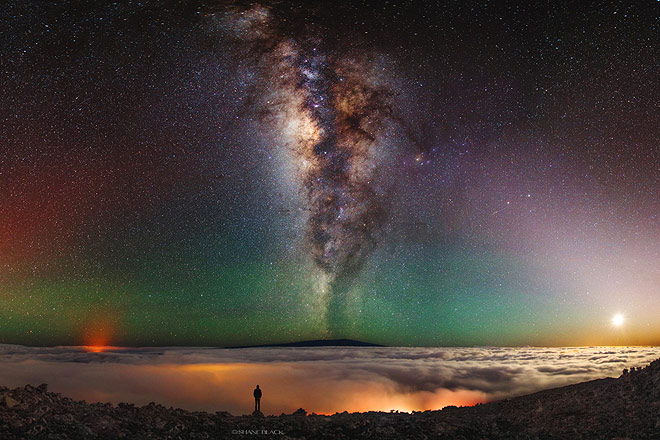USA: Mauna Kea Observatory The dormant volcano of Mauna Kea on Big Island in Hawaii is a unique

USA: Very Large Array
Remember that shot of a vast plain glittering with white radio telescopes from the science fiction movie Contact? Well, it’s a real-life radio observatory called the Very Large Array (VLA) located on the San Agustin Plains of New Mexico. At a height of 6,970ft above sea level, the VLA forms a vital component of the National Radio Astronomy Observatory. The 27 antennae monitor and investigate a vast swathe of space and astronomical objects, looking into the working of radio galaxies, quasars, supernovas and what-have-you. Evidently, it’s an exciting place to visit! And you can do so any day of the year. The VLA is open to visitors everyday from 8:30am to sunset, and you can take a self-guided walking tour ($6 for adults, ages 17 and under free; public.nrao.edu/tours/visitvla). The tour takes you to one of the working antennae and you can get a sense of the astronomical work that the radio telescope does. You can also view an award-winning film on the VLA at the visitors’ centre narrated by the actress Jodie Foster. Guided tours of the facility are offered on the first Saturday of every month. These tours lasts for 45 minutes and culminates in a free guided viewing of the night sky through a telescope located at the campus of NM Tech at the nearby town of Socorro. A gift shop is open from 9am to 4pm in case you want some souvenirs. The VLA is an 80km drive from the city of Albuquerque in New Mexico.

England: Greenwich Observatory
To give it its proper name, the Royal Observatory (rmg.co.uk/royal-observatory) at Greenwich in London is one of the most prestigious sites associated with astronomy in the world. Home to the Prime Meridian that literally splits the world in two, as well as lending its name to the basis of determining global time zones with the Greenwich Meridian Time (it’s called Universal Time, or UT, these days) the observatory has played an important role in the history of astronomy. Although all scientific work has long been shifted out to other locations, the observatory continues to function as a museum to astronomy. As a result, it’s probably one of the most popular tourist draws in the London area. There’s much to see and do here, but here are a couple of things you must absolutely do. The first of these is a visit to the observatory itself. Set atop a small hill overlooking the Thames, go on a day-long self-guided tour (£9.50 for adults; £5 for children), beginning at the Meridian Courtyard, where you can see the famous brass strip that signifies the Meridian Line. Learn about the many stories associated with the observatory (built in 1676), visit the Astronomer Royal’s house, make some solar observations and participate in science demonstrations. You should also attend a Planetarium Show (£7.50 for adults; £5.50 for children) presented live by a Royal Observatory Astronomer. It’s a great way to explore the solar system as well as thrilling deep space objects. Apart from these, there are a whole host of free activities that you can explore here.

Chile: The Paranal Observatory
Located in the trackless wastes of Chile’s Atacama Desert, overlooking the Pacific Ocean in the distance, the telescopes of the Paranal Observatory are some of the most cutting edge in the world. One of the three observing sites of the European Southern Observatory (the other two are in La Silla and Chainator, also in Chile), the Very Large Telescope array at Paranal is the flagship observatory. Composed of not one, but four ‘Unit Telescopes’, it produces images four billion times sharper than what can be seen by the naked eye. The height of the site, at over 8,000ft also helps to make Paranal one of the finest places to observe the sky, second only to Mauna Kea. Right now, Paranal is leading the search for exoplanets in distant galaxies, and, as you can imagine, the VLA array at Paranal would be a pretty exciting place to visit. The observatory allows weekend visits for free guided tours of the facility. While on the tour, you will be taken to the VLA platform and enter one of the enclosures to see the main telescope. You can also visit the control room where the astronomers work, and also visit the uniquely built base where all the people working at the observatory live, the Paranal Residencia.

South Africa: South Africa Astronomical Observatory, Sutherland
If you’ve visited Cape Town, you might have heard the famous ‘noon gun’ that’s fired every day from Signal Hill. What you might not know is that its fired at 12pm by a time signal generated by the South African Astronomical Observatory, or SAAO, located at Sutherland in the Northern Cape. This observatory, with its many major telescopes, including the famous SALT (South African Large Telescope) probe and investigate the night sly for the secrets of the universe. The headquarters of the SAAO is situated in Cape Town, which you can visit for its planetarium and collection of historic telescopes. However, a trip some 370km inland is a must if you wish to see the site where the actual observing takes place. You can opt for Day Tours (R60 for adults and R30 for children) and Night Tours (R80 for adults and R40 for children). The Day Tour includes a guided walk through the Visitor Centre and a tour of some of the main telescopes including the SALT, the largest single optical telescope in the southern hemisphere. Night Tours include the viewing of the night sky through two specially designated visitor telescopes. However, you can’t visit any of the research telescopes as astronomers would be at work.
astronomy
Bibek Bhattacharya
Mauna Kea Observatory


